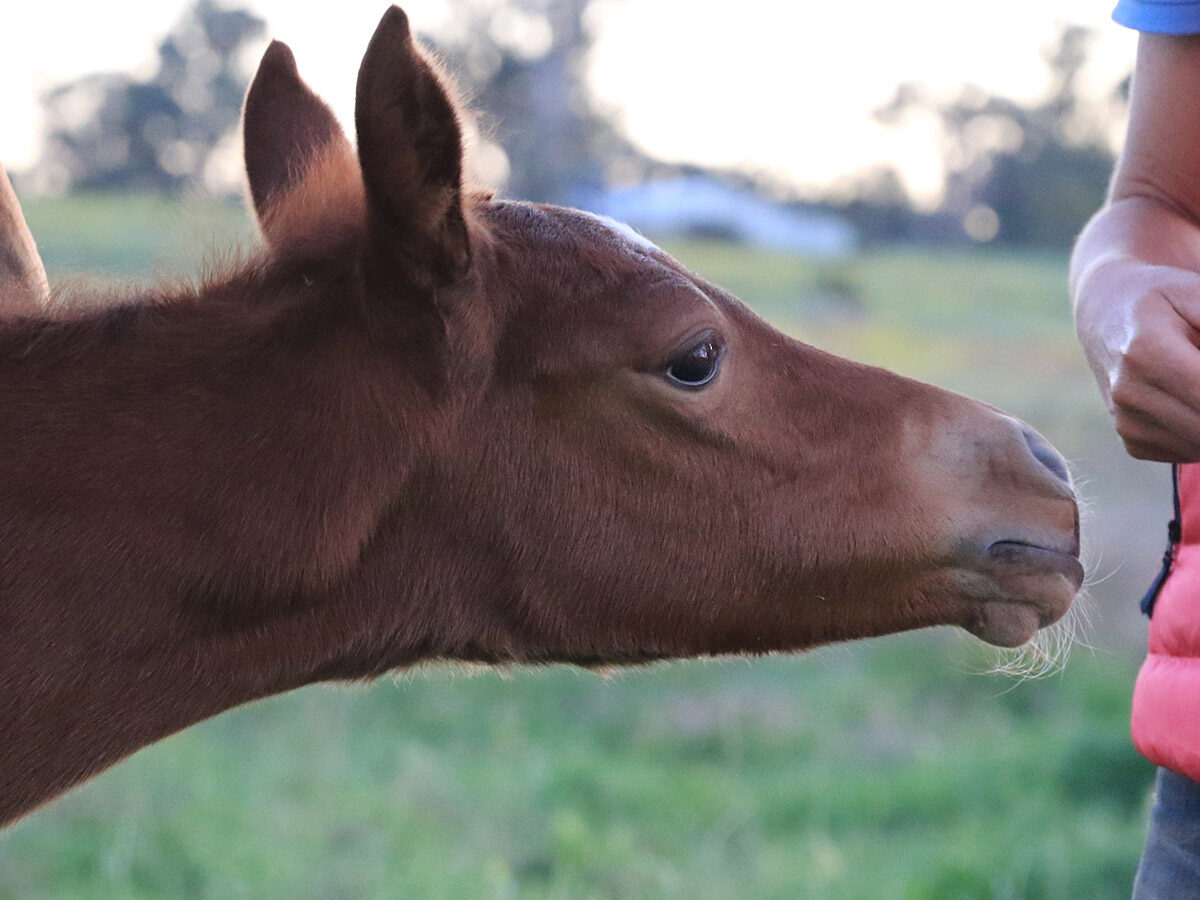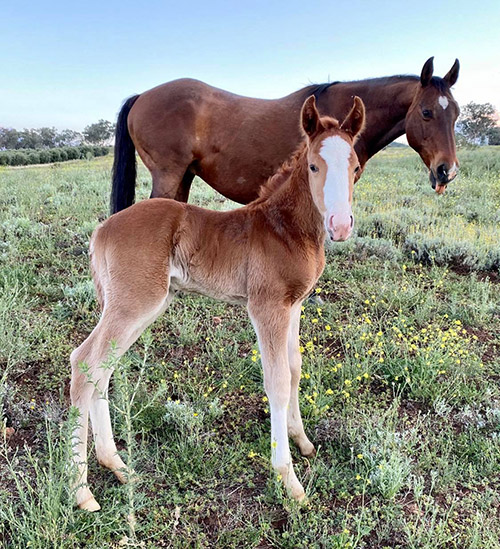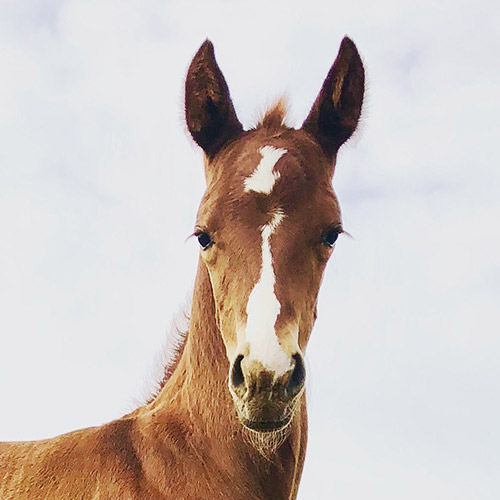It’s around this time of year that some horse people – particularly mare owners – ask themselves: “Should I breed a foal?” It’s a good question, and one that warrants thorough investigation before answering yes or no.

“Am I financially, emotionally
and logistically able to handle it?”
Breeding your dream foal can indeed turn out to be a dream come true – however, buying the horse you want, one that suits your current situation, ability and needs, may well be the most successful, cost-effective and reliable option in the quest for the perfect horse.
Anyone considering breeding a foal for the first time should seek advice, guidance and mentorship from those experienced in this area, such as reproductive veterinarians and horse stud owners. Here we take a preliminary look at the key points to consider when deciding whether to go down the path of bringing an equine life into this world.
Breeding and raising a foal from birth through to adulthood is an extremely rewarding and exciting process – when it all goes to plan! After carefully choosing the right stallion and mare match, then the thrill of positive pregnancy scans and a long but worthwhile 11-month wait, the foal you have been dreaming of finally arrives! Hours will be spent delighting in the newborn’s antics as he or she finds his feet, learns how to co-ordinate those gangly limbs, and reaches key milestones with ease as he grows and develops into the horse you’d planned he’d be.
Unfortunately, the journey is usually not so straightforward. There are often curve balls, unexpected costs and sometimes heartbreak along the way; as the saying goes, “breeding is not for the faint-hearted!” For every true story about a wonderful mare who produced a beautiful foal possessing all of the mare’s and stallion’s best attributes, there are counter stories – also true – about mares with fertility issues, lost pregnancies, foals born with health challenges, tragic losses, and promising foals who nevertheless failed to grow into the horse the breeder hoped and expected they’d be. All of these stories need to be heard; the breeding process can be smooth sailing and yield wonderful results, and it can be a disaster. Understanding that both outcomes, and every range of scenarios in between, could occur is key; as is asking yourself, “Come what may, am I financially, emotionally and logistically able to handle it?”
START WITH WHY
Have an honest think about why you want to breed a foal. Is it because your mare is injured or retired and you therefore feel that you may as well? Is it because there’s a stallion standing at stud who you really like, and you desperately want to breed a horse by him? Is it because you want to go on the journey of knowing a horse from birth through to adulthood, and the opportunity to train that horse from scratch? It’s usually a combination of reasons, none of which are right or wrong.
However, take the next step and ask yourself how confident you are that you’ll feel and be the same in five years’ time, when the horse is four years old. Personal circumstances change and it’s not uncommon to see homebred horses on the market before they have reached ridden age due to a change in the owner’s direction or circumstances. That is life – however, if it happens to you, will the foal you intend to breed be marketable? This does not mean it needs to be by the fanciest stallion in your preferred breed or discipline, but when choosing to bring an equine life into being, it’s responsible and ethical to remember that this may be an animal that lives for 30 years. You may own that animal for the entirety of its life, however, if you don’t, will it be an animal that is likely to find a good home?



“Many of us are blind
to our horse’s faults
and shortcomings!”
A LOOK AT THE LOGISTICS
Once you’ve sorted out the “why”, it’s time to critically evaluate your set-up and situation. If you’re planning to keep your mare at home throughout her pregnancy, to foal down, and while the foal is at foot, do you have the facilities required? Paddocks with foal safe fencing, ideally close to your house so you can monitor the mare during pregnancy and the newborn foal easily, plus solid yards or stables are required; without these facilities, it’s worthwhile investigating the costs and logistics of sending the mare to foal down at a veterinary or stud facility. Think further ahead to weaning time and beyond; do you have a large enough property to safely separate the mare and foal, and will the foal have a companion and enough space to learn to “be a horse” as he grows into a playful and energetic yearling?
Be aware that tiny foals soon become rambunctious young creatures weighing hundreds of kilos; if you don’t have the skills and knowledge to handle a foal, you will need to involve someone who does, or board the foal at a facility with the requisite knowledge.
KNOW THE COSTS
When budgeting to breed a foal, don’t get too carried away with how much you can afford to spend on a service fee before understanding how much the entire process is likely to cost – from initial scans until the horse you breed reaches breaking-in age, with some contingency for unexpected veterinary issues along the way. Just as it can be said that the purchase price is the cheapest part of owning a horse, so it can be said that the stallion’s service fee is the cheapest part of breeding a horse.
Some costs will be dependent on whether the stallion you breed to is located locally and offers live cover, or artificial insemination only. Due to advances in veterinary and reproductive science and the subsequent growth in the popularity of using frozen, chilled or fresh semen via artificial insemination, it is likely that AI will be used and the veterinary, semen collection and freight costs involved in breeding the mare will come close to – or possibly exceed – the cost of the stallion service fee, particularly if the mare does not fall pregnant on the first attempt.
Utilising the services of a veterinarian who specialises in equine reproduction is highly recommended. Their skill and expertise plays a significant part in the success of the breeding process, and they will be able to quote a fee structure upfront to assist your budgeting; many offer packages that cover everything involved in each insemination cycle including all scans, and in some cases, care at the veterinary practice. Others charge in an itemised manner.
THE MARE MATTERS
If you already own a mare you plan to breed from, it’s important to objectively evaluate her suitability as a broodmare. The desire to breed from a mare you own can be emotional rather than wise; she may have been a wonderful horse for you, however, there is no guarantee that she will produce a foal with the same attributes she displays. If you are considering breeding her because she has had a career-ending injury or condition, be honest with yourself about whether this was caused by a conformation or genetic fault or limitation. If you are not experienced in evaluating conformation, ask for the help of someone who is – after all, many of us are blind to our horse’s faults and shortcomings! This applies to her temperament too; if it is less than ideal, it’s not as simple as choosing a stallion with a kindly disposition and hoping that this will dominate. The mare matters – whilst the genetic contribution of mares and stallions is equal, the mare is the one who will raise the foal and her character will have some influence on the foal, unless of course embryo transfer to a surrogate is utilised. Even then, the nature versus nurture element must be considered!


If you are planning to buy or lease a mare to breed with, choosing one that has produced foals in recent years is recommended. Maiden mares can be wonderful mothers and have trouble-free pregnancies, but if you are breeding a foal for the first time you may find the process of managing an equally inexperienced mare through the process quite stressful! Critically assess a broodmare prospect’s bloodlines, conformation, temperament and, if possible and applicable, her previous progeny. Are they consistent and correct in type? Do they seem to take after their dam, or throw more to the stallion’s side? Some mares seem to produce foals in their own image; others throw more to the stallion. Which would you prefer?
Before committing to breeding from any mare, arrange a breeding soundness examination with a veterinarian experienced in equine reproduction to ensure she is suitable for the task ahead.
THE SEARCH FOR A STALLION
Now for the exciting part — choosing a stallion! You may already have one, or a few in mind. There are abundant choices in today’s market, from Australian born and bred horses, to imported stallions, to international frozen semen options. Don’t shy away from discussing the stallions you are considering with their owners or agents; they will typically be very open and willing to discuss specific details about their stallions which will help guide your choices. Be realistic about what you want and need. While it’s certainly sage advice to breed the best mare you can possibly access to the best stallion you can afford, if this will produce an extreme athlete with a temperament best suited to a professional rider and your ambitions don’t involve competing in elite level sport, is it the right match of mare and stallion for your situation and needs?
Most stallion owners and agents can also advise you on the style of mare their stallions cross best with, and you can also do your own research in this regard. Unless you are considering a young stallion, you should be able to see pictures and footage of his offspring. Research horses further back in both the stallion’s and mare’s pedigrees too; throwbacks do occur from time to time – are there any names lurking on those pedigree charts with a reputation for producing poor temperaments or soundness issues?
Be aware of any conformation or genetic issues that may arise from crossing your mare with a particular stallion; for example, two carriers of genetic diseases such as Warmblood Fragile Foal Syndrome (WFFS), or Herda in Quarter Horses, should not be bred to each other. Conformation issues are not quite so black or white; perhaps you have a mare who is a little long in the back? Choosing a compact stallion will increase your chances of breeding a shorter backed foal — however, it is no guarantee: when it comes to breeding, A + B does not always equal C. Similarly, you can’t expect to breed a 17hh mare to a 15hh stallion and produce a foal who grows to 16hh – you might, however, the resultant foal may end up shorter or taller than both of its parents! If you have very specific desires when it comes to the attributes your foal displays, buying a young horse may be a better option than breeding one.

“There is nothing quite like
the pride a breeder feels when a horse…
goes on to achieve great things.”
THE LONG WAIT
Once you have committed to breeding a mare, chosen a stallion, found a veterinarian to work with, and developed a plan for where your foal will be born and raised, it’s time to set the wheels in motion! With some luck, the mare will fall pregnant within the first few attempts, and remain in foal at her all-important 15 and 45-day scans. With an average gestation period of 342 days, it can feel like an agonising wait for the bundle of joy to arrive. However, this time can be used wisely to prepare yourself for the impending arrival. Foaling is an extremely exciting yet nerve-wracking time; being prepared and educated for the later stages of pregnancy, birth, and neonatal care is critical. Be sure to know the signs of conditions such as placentitis during pregnancy and dystocia during birth, the key milestones a foal should reach in its first few hours of life, and the symptoms of diseases such as joint ill that can affect young foals.
There is nothing quite like the pride a breeder feels when a horse they carefully planned, bred and produced goes on to achieve great things, however these are defined – either for themselves, or for their next owner. With some luck on your side, breeding a foal is one of the most rewarding processes a horse lover can experience – the key is understanding the risks and challenges before embarking on the journey and knowing whether it is one you’re willing to undertake. EQ

